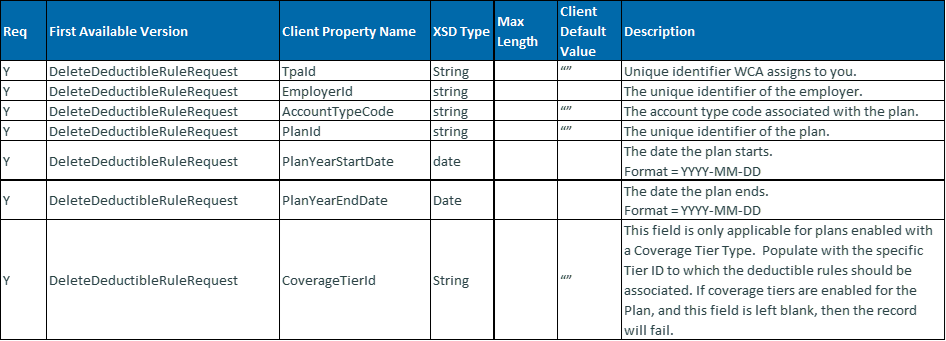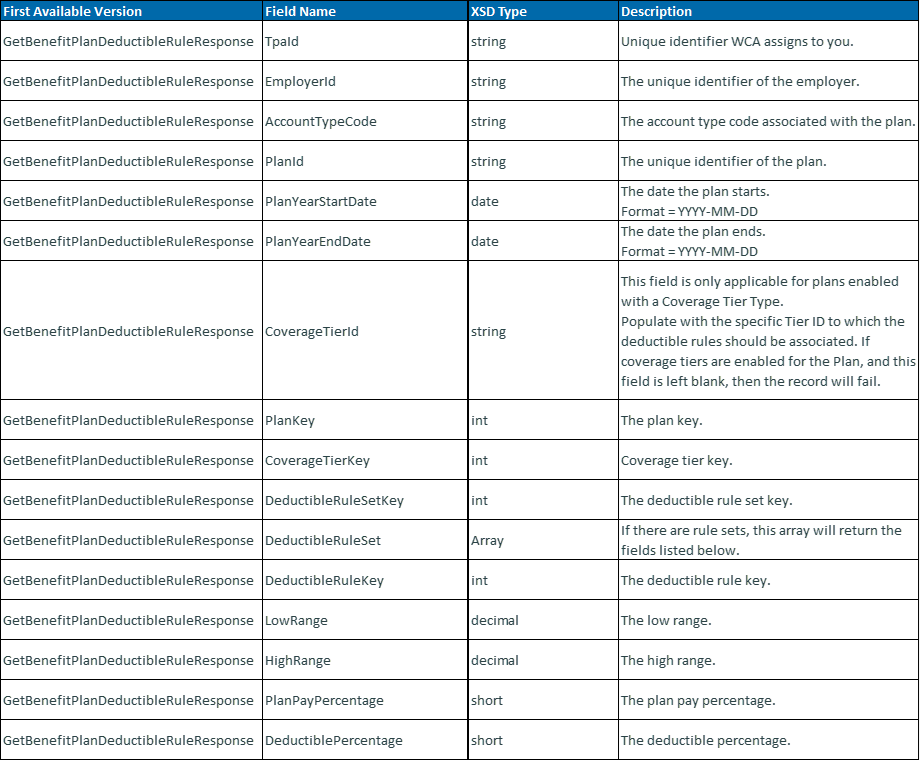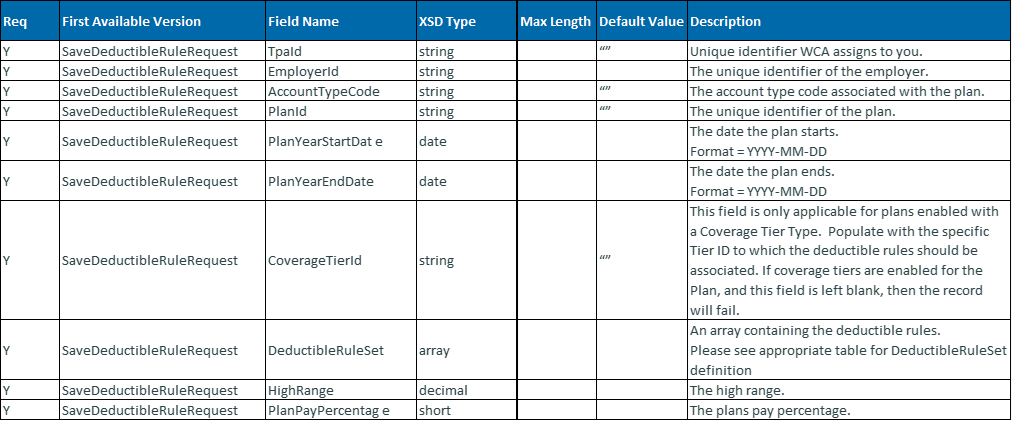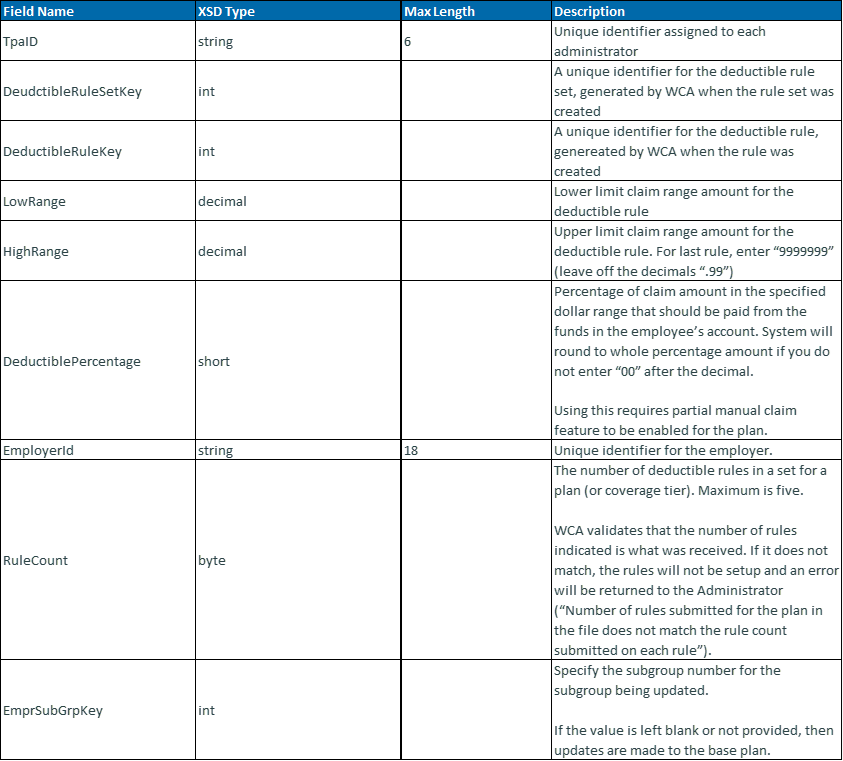
Plan Deductible Rules API | Administrative - SOAP
The PlanDeductibleRule service allows clients the ability to read, add, update, and delete the deductible rules on a plan.
Service web methods
The following operations are supported:
DeleteDeductibleRules - This method is used to delete a set of deductible rules on a plan.
GetBenefitPlanDeductibleRules - This method is used to retrieve a set of deductible rules on a plan.
SaveDeductibleRules - This method is used to insert or update a set of deductible rules on a plan.
Service assumptions/business rules
The PlanDeductibleRule service makes the following assumptions and enforces the following business rules:
Clients shall conform to the WS-I specifications unless otherwise agreed upon by Alegeus and the administrator.
Clients shall format SOAP messages in a document/literal format over HTTPS.
Clients shall have already created a valid user ID and password.
Clients shall have a valid session ID after being authenticated by the system. The session ID needs to be passed in the proper manner as described in the account manager service guide.
If the administrator uses the same user ID and password for all of their clients, the administrator is responsible for managing the security of the data.
Clients should validate data before submitting a request to this service. This facilitates better performance and accurate processing on both systems.
Clients shall not attempt to use this service for batch processing of large amounts of data. The service is designed for synchronous calls that send or retrieve small chunks of data. If batch processing is required, then the EDI process should be used.
If any method fails, the service returns a SOAP fault describing the problem.
DeleteDeductibleRules
This method is used to delete a set of deductible rules on a plan.
History
The DeleteDeductibleRules methods are listed below:
Request messages
DeleteDeductibleRule
Response messages
DeleteDeductibleRuleResponse
DeleteDeductibleRules request/response messages
The DeleteDeductibleRules method requires the following request and response messages (input and output data).
The table below includes the following request messages:
• DeleteDeductibleRuleRequest

Response message: Empty response.
Example of DeleteDeductibleRules SOAP request message
<?xml version="1.0" encoding="utf-8"?>
<soap:Envelope xmlns:xsi="http://www.w3.org/2001/XMLSchema-instance" xmlns:xsd="http://www.w3.org/2001/XMLSchema" xmlns:soap="http://schemas.xmlsoap.org/soap/envelope/">
<soap:Header>
<MBISessionHeader xmlns="http://www.medibank.com/MBIWebServices/SoapHeader/">
<MBISessionID>string</MBISessionID>
</MBISessionHeader>
</soap:Header>
<soap:Body>
<DeleteDeductibleRuleRequest
xmlns="http://www.medibank.com/MBIWebServices/Plan/Messages/DeductibleRule/Request/2008/07/">
<request>
<TpaId>string</TpaId>
<EmployerId>string</EmployerId>
<AccountTypeCode>string</AccountTypeCode>
<PlanId>string</PlanId>
<PlanYearStartDate>date</PlanYearStartDate>
<PlanYearEndDate>date</PlanYearEndDate>
<CoverageTierId>string</CoverageTierId>
</request>
</DeleteDeductibleRuleRequest>
</soap:Body>
</soap:Envelope>
Example of DeleteDeductibleRules SOAP response message
<?xml version="1.0" encoding="utf-8"?>
<soap:Envelope xmlns:xsi="http://www.w3.org/2001/XMLSchema-instance" xmlns:xsd="http://www.w3.org/2001/XMLSchema" xmlns:soap="http://schemas.xmlsoap.org/soap/envelope/">
<soap:Header>
<MBIMessageIdHeader xmlns="http://www.medibank.com/MBIWebServices/SoapHeader/">
<MessageId>string</MessageId>
</MBIMessageIdHeader>
</soap:Header>
<soap:Body>
<DeleteDeductibleRuleResponse
xmlns="http://www.medibank.com/MBIWebServices/Plan/Messages/DeductibleRule/Response/2008/07/">
<DeleteDeductibleRulesResult />
</DeleteDeductibleRuleResponse>
</soap:Body>
</soap:Envelope>
Example client code
The following is an example of the client code (using a .NET proxy class for accessing the service) used when calling the DeleteDeductibleRules web method.
try
{
// create new SOAP header for the user’s current session id localhost.MBISessionHeader sh = new localhost.MBISessionHeader();
// create the proxy object for the service localhost.PlanDeductibleRuleService proxy = new localhost.PlanDeductibleRuleService();
// create a new request object for the method’s parameters
localhost.DeleteDeductibleRules request = new localhost.DeleteDeductibleRules();
// set the parameters for the web method call
request.TpaId = "T00021";
request.EmployerId = "MedSC";
request.AccountTypeCode = “FSA”;
request.PlanId = “FSA2009”;
request.PlanYearStartDate = 2009-01-01;
request.PlanYearEndDate = 2009-12-31;
request.CoverageTierId = “CVRTIER1”;
// Add the session SOAP header so that the service knows who we are.
// Note that we stored the session ID in a member variable after
// logged in to the system for future web method calls.
sh.MBISessionID = _sessionID;
proxy.MBISessionHeaderValue = sh;
// Call the web method.
proxy.DeleteDeductibleRules(request);
MessageBox.Show("Finished");
}
catch(SoapException se)
{
// perform needed operations
}
catch(Exception ex)
{
// perform needed operations
}
GetBenefitPlanDeductibleRules
This method is used to retrieve existing deductible rules on an existing plan.
History
The GetBenefitPlanDeductibleRules methods are listed below:
Request messages
GetBenefitPlanDeductibleRuleRequest
Response messages
GetBenefitPlanDeductibleRuleResponse
GetBenefitPlanDeductibleRules request/response messages
The GetBenefitPlanDeductibleRules method requires the following request and response messages (input and output data).
The table below includes the following request messages:
GetBenefitPlanDeductibleRuleRequest

The table below includes the following response messages:
GetBenefitPlanDeductibleRuleResponse

Example of GetBenefitPlanDeductibleRules SOAP request message
<?xml version="1.0" encoding="utf-8"?>
<soap:Envelope xmlns:xsi="http://www.w3.org/2001/XMLSchema-instance" xmlns:xsd="http://www.w3.org/2001/XMLSchema"
xmlns:soap="http://schemas.xmlsoap.org/soap/envelope/">
<soap:Header>
<MBISessionHeader xmlns="http://www.medibank.com/MBIWebServices/SoapHeader/">
<MBISessionID>string</MBISessionID>
</MBISessionHeader>
</soap:Header>
<soap:Body>
<GetBenefitPlanDeductibleRuleRequest
xmlns="http://www.medibank.com/MBIWebServices/Plan/Messages/DeductibleRule/Request/2008/07/">
<request>
<TpaId>string</TpaId>
<EmployerId>string</EmployerId>
<AccountTypeCode>string</AccountTypeCode>
<PlanId>string</PlanId>
<PlanYearStartDate>date</PlanYearStartDate>
<PlanYearEndDate>date</PlanYearEndDate>
<CoverageTierId>string</CoverageTierId>
</request>
</GetBenefitPlanDeductibleRuleRequest>
</soap:Body>
</soap:Envelope>
Example of GetBenefitPlanDeductibleRules SOAP response message:
<?xml version="1.0" encoding="utf-8"?>
<soap:Envelope xmlns:xsi="http://www.w3.org/2001/XMLSchema-instance" xmlns:xsd="http://www.w3.org/2001/XMLSchema" xmlns:soap="http://schemas.xmlsoap.org/soap/envelope/">
<soap:Header>
<MBIMessageIdHeader xmlns="http://www.medibank.com/MBIWebServices/SoapHeader/">
<MessageId>string</MessageId>
</MBIMessageIdHeader>
</soap:Header>
<soap:Body>
<GetBenefitPlanDeductibleResponse
xmlns="http://www.medibank.com/MBIWebServices/Plan/Messages/DeductibleRule/Response/2008/07/">
<GetBenefitPlanDeductibleRulesResult>
<TpaId>string</TpaId>
<EmployerId>string</EmployerId>
<AccountTypeCode>string</AccountTypeCode>
<PlanId>string</PlanId>
<PlanYearStartDate>date</PlanYearStartDate>
<PlanYearEndDate>date</PlanYearEndDate>
<CoverageTierId>string</CoverageTierId>
<PlanKey>int</PlanKey>
<CoverageTierKey>int</CoverageTierKey>
<DeductibleRuleSetKey>int</DeductibleRuleSetKey>
<DeductibleRuleSet>
<DeductibleRuleKey>int</DeductibleRuleKey>
<LowRange>decimal</LowRange>
<HighRange>decimal</HighRange>
<PlanPayPercentage>short</PlanPayPercentage>
<DeductiblePercentage>short</DeductiblePercentage>
</DeductibleRuleSet>
<DeductibleRuleSet>
<DeductibleRuleKey>int</DeductibleRuleKey>
<LowRange>decimal</LowRange>
<HighRange>decimal</HighRange>
<PlanPayPercentage>short</PlanPayPercentage>
<DeductiblePercentage>short</DeductiblePercentage>
</DeductibleRuleSet>
</GetBenefitPlanDeductibleRulesResult>
</GetBenefitPlanDeductibleResponse>
</soap:Body>
</soap:Envelope>
Example client code
The following is an example of the client code (using a .NET proxy class for accessing the service) used when calling the GetBenefitPlanDeductibleRules web method.
try
{
// create new SOAP header for the user’s current session id localhost.MBISessionHeader sh = new localhost.MBISessionHeader();
// create the proxy object for the service
localhost.PlanDeductibleRuleService proxy = new localhost.PlanDeductibleRuleService();
// create a new request object for the method’s parameters
localhost.GetBenefitPlanDeductibleRules request = new localhost.GetBenefitPlanDeductibleRules(); localhost.GetBenefitPlanDeductibleRulesResponse resp;
// set the parameters for the web method call
request.TpaId = "T00021";
request.EmployerId = "MedSC";
request.AccountTypeCode = “FSA”;
request.PlanId = “FSA2009”;
request.PlanYearStartDate = 2009-01-01;
request.PlanYearEndDate = 2009-12-31;
request.CoverageTierId = “CVRTIER1”;
// Add the session SOAP header so that the service knows who we are. // Note that we stored the session ID in a member variable after
// logged in to the system for future web method calls.
sh.MBISessionID = _sessionID;
proxy.MBISessionHeaderValue = sh;
// Call the web method.
resp = proxy.DeleteDeductibleRules(request);
MessageBox.Show("Finished");
}
catch(SoapException se)
{
// perform needed operations
}
catch(Exception ex)
{
// perform needed operations
}
SaveDeductibleRules
This method is used to insert or update plan deductible rules on an existing plan.
History
The SaveDeductibleRules methods are listed below:
Request messages
SaveDeductibleRuleRequest
Response messages
SaveDeductibleRuleResponse
SaveDeductibleRules request/response messages
The SaveDeductibleRules method requires the following request and response messages (input and output data). The table below includes the following request messages:
• SaveDeductibleRuleRequest

The table below includes detail for the DeductibleRuleSet object:

Response message: Empty message.
Example of SaveDeductibleRules SOAP request message:
<?xml version="1.0" encoding="utf-8"?>
<soap:Envelope xmlns:xsi="http://www.w3.org/2001/XMLSchema-instance" xmlns:xsd="http://www.w3.org/2001/XMLSchema" xmlns:soap="http://schemas.xmlsoap.org/soap/envelope/">
<soap:Header>
<MBISessionHeader xmlns="http://www.medibank.com/MBIWebServices/SoapHeader/">
<MBISessionID>string</MBISessionID>
</MBISessionHeader>
</soap:Header>
<soap:Body>
<SaveDeductibleRuleRequest
xmlns="http://www.medibank.com/MBIWebServices/Plan/Messages/DeductibleRule/Request/2008/07/">
<request>
<TpaId>string</TpaId>
<EmployerId>string</EmployerId>
<AccountTypeCode>string</AccountTypeCode>
<PlanId>string</PlanId>
<PlanYearStartDate>date</PlanYearStartDate>
<PlanYearEndDate>date</PlanYearEndDate>
<CoverageTierId>string</CoverageTierId>
<DeductibleRuleSet>
<HighRange>decimal</HighRange>
<PlanPayPercentage>short</PlanPayPercentage>
</DeductibleRuleSet>
<DeductibleRuleSet>
<HighRange>decimal</HighRange>
<PlanPayPercentage>short</PlanPayPercentage>
</DeductibleRuleSet>
</request>
</SaveDeductibleRuleRequest>
</soap:Body>
</soap:Envelope>
Example of SaveDeductibleRules SOAP response message
<?xml version="1.0" encoding="utf-8"?>
<soap:Envelope xmlns:xsi="http://www.w3.org/2001/XMLSchema-instance" xmlns:xsd="http://www.w3.org/2001/XMLSchema"
xmlns:soap="http://schemas.xmlsoap.org/soap/envelope/">
<soap:Header>
<MBIMessageIdHeader xmlns="http://www.medibank.com/MBIWebServices/SoapHeader/">
<MessageId>string</MessageId>
</MBIMessageIdHeader> </soap:Header> <soap:Body>
<SaveDeductibleRuleResponse
xmlns="http://www.medibank.com/MBIWebServices/Plan/Messages/DeductibleRule/Response/2008/07/">
<SaveDeductibleRulesResult />
</SaveDeductibleRuleResponse>
</soap:Body>
</soap:Envelope>
Example client code
The following is an example of the client code (using a .NET proxy class for accessing the service) used when calling the SaveDeductibleRules web method.
try
{
// create new SOAP header for the user’s current session id localhost.MBISessionHeader sh = new localhost.MBISessionHeader();
// create the proxy object for the service
localhost.SaveDeductibleRules proxy = new localhost.SaveDeductibleRules();
// set the parameters for the web method call
request.TpaId = "T00021";
request.EmployerId = "MedSC";
request.AccountTypeCode = “FSA”;
request.PlanId = “FSA2009”;
request.PlanYearStartDate = 2009-01-01;
request.PlanYearEndDate = 2009-12-31;
request.CoverageTierId = “CVRTIER1”;
request.DeductibleRuleSet.HighRange = 1000d;
request.DeductibleRuleSet.PlanPayPercentage = 10;
// Add the session SOAP header so that the service knows who we are.
// Note that we stored the session ID in a member variable after
// logged in to the system for future web method calls.
sh.MBISessionID = _sessionID;
proxy.MBISessionHeaderValue = sh;
// Call the web method.
proxy.SaveDeductibleRules(request);
MessageBox.Show("Finished");
}
catch(SoapException se)
{
// perform needed operations
}
catch(Exception ex)
{
// perform needed operations
}
Copyright © 2023 Alegeus Technologies, LLC. All rights reserved. Alegeus, Alegeus Technologies, WealthCare, WealthCare Saver are registered trademarks of Alegeus Technologies, LLC